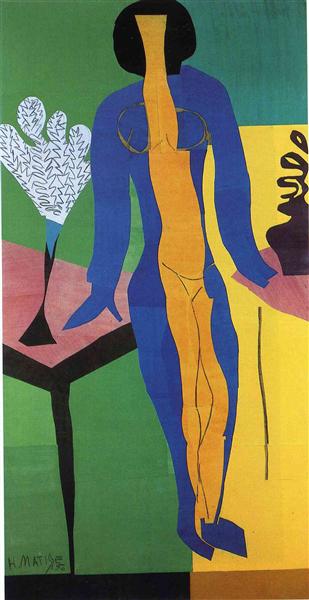Description
In the work "Zulma" created in 1950, Henri Matisse displays a masterful synthesis of form and color, characteristic of his last creative stage. This oil on canvas, with dimensions of 31 x 60 cm, represents a stylized female figure, whose name gives the title to the work. The figure of Zulma is representative of the minimalist and bold approach that Matisse adopted in his later years, where the precision of the stroke and the vividness of the color emerge as main elements.
The composition of "Zulma" is simple but profoundly effective. The female figure, matured in flat colors, is placed in a posture that hints at an almost monumental serenity. Matisse focuses on delineating the contour with clear and precise lines, while the chromatic fill unfolds in a vibrant and harmonious palette. The use of strong colors like blue and yellow, skillfully contrasted with earthy tones, shows the artist's preference for dynamic contrasts and emotional expression through the bold use of color.
One of the most striking aspects of the work is the total absence of detail in Zulma's face. Instead of seeking individuality through physiognomic portraiture, Matisse opts for a generalization of the human form, which gives the figure a universal and timeless character. This stylistic resource forces the viewer to focus more on the composition and the interaction of colors than on the personal identification of the depicted figure.
It is notable how Matisse, in the creation of "Zulma" and other works from his last phase, ventures into an exploration of pictorial space through simplification and the expansive use of color. This work falls within the period when Matisse began to work extensively with cut-out painted paper (papiers découpés), a technique that allowed him to continue creating despite the physical limitations imposed by his illness.
The influence of his work on modern art cannot be underestimated. "Zulma" can be seen as a precursor to the abstraction and minimalism that emerged in the following decades. The way Matisse manages to communicate so much with so little is a testament to his ability to reduce life to its most poetic visual essences. This consolidated him not only as a master of color but as a pioneer in the search for new visual languages.
Henri Matisse cemented his legacy by exploring every possible corner of artistic expression. His transition from large canvases full of elements to minimalist compositions like "Zulma" is a reflection of his constant evolution and desire for new horizons. In "Zulma", we find an introspective and essential Matisse, whose innovative gaze and radical technique continue to inspire and challenge artists and viewers alike.

